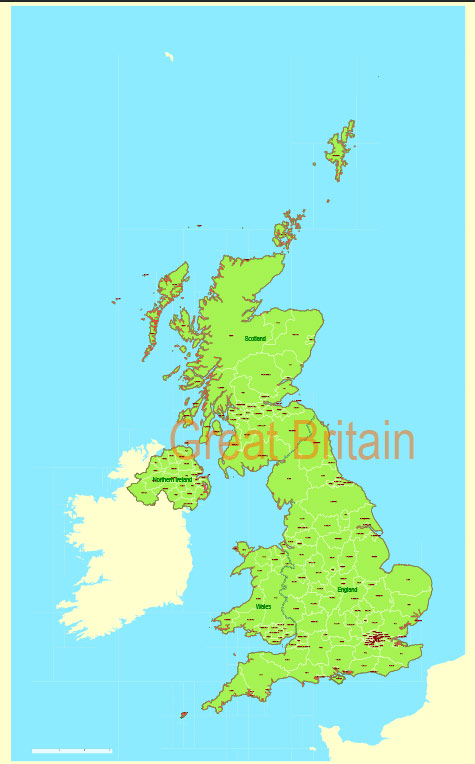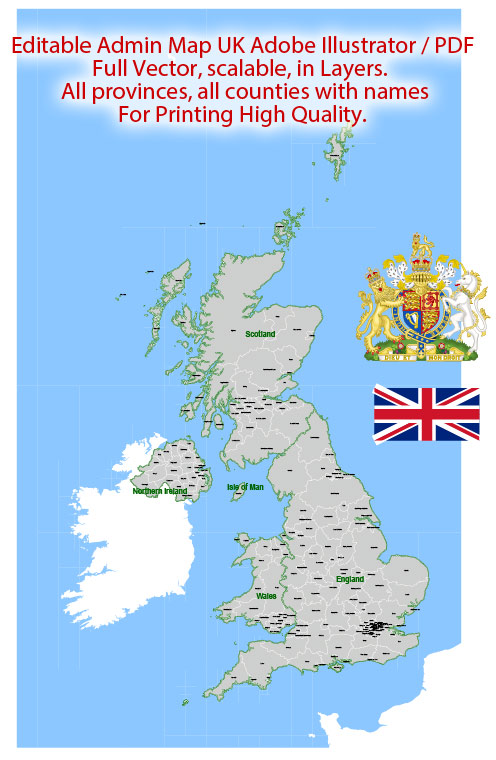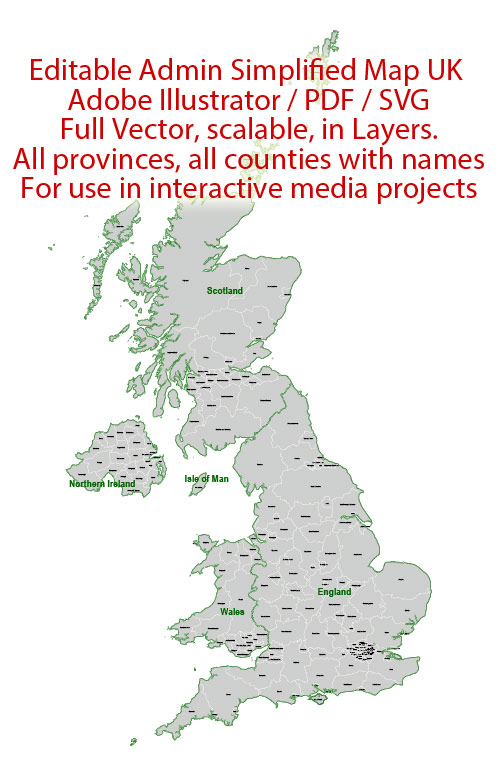The history and transportation infrastructure of the United Kingdom, specifically Great Britain, is a rich and evolving story that spans centuries.
Vectormap.Net provide you with the most accurate and up-to-date vector maps in Adobe Illustrator, PDF and other formats, designed for editing and printing. Please read the vector map descriptions carefully.
Let’s delve into both aspects to provide a comprehensive overview:
History:
Early Settlements and Roman Period:
- Prehistoric Period: The earliest evidence of human settlement in the area that is now the UK dates back to the Paleolithic era. Over the centuries, various Celtic tribes settled in the region.
- Roman Britain (43–410 AD): The Romans invaded and established control over Britain, constructing roads, Hadrian’s Wall, and other infrastructure. The Roman road network, such as Ermine Street and Watling Street, greatly influenced future transportation routes.
Anglo-Saxon and Viking Periods:
- Anglo-Saxon Period (410–1066 AD): After the fall of the Roman Empire, Germanic tribes, mainly the Anglo-Saxons, settled in England. This period saw the establishment of Anglo-Saxon kingdoms and the spread of Christianity.
- Viking Invasions (8th–11th centuries): Vikings, particularly from Denmark and Norway, raided and settled in parts of Britain. This period saw the emergence of the Danelaw, areas under Viking control.
Norman Conquest and Medieval Period:
- Norman Conquest (1066): William the Conqueror, Duke of Normandy, defeated King Harold II at the Battle of Hastings, leading to the Norman conquest of England.
- Medieval Period (11th–15th centuries): The construction of castles, cathedrals, and the development of towns characterized this era. Trade routes expanded, and the Magna Carta in 1215 marked a key development in constitutional history.
Tudor and Stuart Periods:
- Tudor Dynasty (1485–1603): The Tudor era, with monarchs like Henry VIII and Elizabeth I, witnessed the English Reformation and exploration, including the voyages of John Cabot.
- Stuart Dynasty (1603–1714): The English Civil War in the 17th century resulted in the temporary establishment of the Commonwealth under Oliver Cromwell. The Glorious Revolution of 1688 led to constitutional changes and the establishment of constitutional monarchy.
Industrial Revolution and Victorian Era:
- 18th–19th Centuries: The Industrial Revolution transformed Britain’s economy, society, and infrastructure. The construction of canals, railways, and factories spurred urbanization and economic growth.
20th Century and Beyond:
- World Wars: The UK played a significant role in both World War I and World War II, impacting the nation’s infrastructure and society.
- Post-war Reconstruction: After World War II, there was a need for reconstruction and the development of social welfare policies.
- Late 20th Century: Economic and cultural changes continued, with the decline of traditional industries and the growth of the service sector.
Modern Period:
- 21st Century: The UK has faced various challenges, including economic shifts, debates over its relationship with the European Union, and societal changes.
Transportation Infrastructure:
Roads:
- Roman Roads: Ancient Roman roads formed the foundation for the road network. Many modern roads, like the A1, A2, and A5, follow the routes of Roman roads.
- Turnpikes: Private turnpike trusts in the 18th century maintained and improved roads, collecting tolls for funding.
Canals:
- Canal Boom: The late 18th and early 19th centuries saw the construction of numerous canals, like the Grand Union Canal and the Bridgewater Canal, to facilitate transportation of goods.
Railways:
- First Railways: The first public railway, the Stockton and Darlington Railway, opened in 1825. This marked the beginning of the railway age, transforming transportation and trade.
Ports and Shipping:
- Maritime History: The UK’s maritime history is extensive, with major ports like Liverpool, London, and Southampton playing crucial roles in global trade and exploration.
Aviation:
- Early Aviation: The UK has a significant history in aviation, from the Wright brothers’ first powered flight in 1903 to the development of military and civilian aviation during the 20th century.
Modern Transportation:
- Highways: The motorway network, initiated in the 1950s and 1960s, expanded significantly, with major routes like the M1 and M6 connecting cities.
- High-Speed Rail: Projects like HS1 (High-Speed 1) and plans for HS2 aim to enhance rail connectivity.
- Airports: London Heathrow is one of the world’s busiest airports, and there are other major airports like Gatwick, Stansted, and Manchester.
Conclusion:
The history and transportation infrastructure of the UK, particularly in Great Britain, reflect a dynamic interplay of social, economic, and technological changes over the centuries. From ancient Roman roads to the modern high-speed rail network, these developments have shaped the nation’s identity and facilitated its role in global trade and commerce.




 Author: Kirill Shrayber, Ph.D.
Author: Kirill Shrayber, Ph.D.